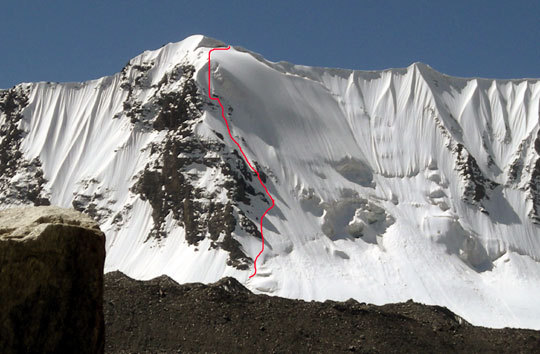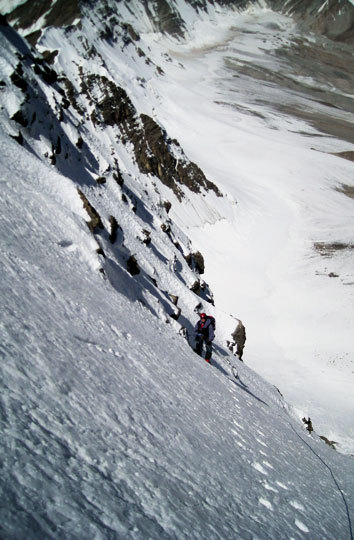
Yilpiz (5313m) rises from the Kuksay Glacier basin immediately east of Muztagh Ata in Chinese Xinjiang. In early August, John Allen, David Barker, Joe Howard and Richard Taylor made the first ascent via the line marked on the north face (TD, Scottish III, 60 degrees, 10 roped pitches). This peak lies on the southern rim of the basin just to the west of Chiatuk, a peak that Allen and Barker had climbed a few days previously. [Photo] John Allen
On July 25 a British expedition comprising John Allen, David Barker, Joe Howard, Kevin and Isobel Mulligan, Richard Taylor and Neil Willatt set up base camp at 4500 meters on the Kuksay Glacier in Chinese Xinjiang. This large basin, immediately east of Muztagh Ata, has seen relatively few visits. The main feature of the Kuksay is the huge southeast ridge of Muztagh Ata (7546m) itself, climbed in an eight-day alpine-style push during the summer of 2000 by Americans Walter Keller, Dan Mazur and Jon Otto. This route was repeated in just five days in 2005 by Kazuya Hiraide and Ms Kei Taniguchi from Japan. However, prior to the British visit the only team that appears to have concentrated solely on the smaller virgin peaks around the rim of the basin was Ulrike Keifer’s South African team in 2001.
After Allen, Howard, Kevin Mulligan and Taylor had acclimatized with a possible first ascent of Pt. 4976m (later christened Kichineky Tagh, the Kyrghyz for small mountain), which forms part of the central rognon of the glacier immediately above base camp (PD, Scottish III), Allen and Barker made the first ascent of Pt. 5582m via the northwest face. This peak lies on the southern rim of the glacial cirque immediately west of Kala Peak (5643m), and the 700-meter face gave crux pitches of Scottish 4 through a central rock band that began at an altitude of ca. 5300m. The last four pitches to the summit were relatively unprotected and rather serious due to unconsolidated snow. The top was reached at 3 p.m. on July 30, and then the route rappelled from rock anchors, a snow bollard and one Abalakov. The two have named the peak Chiatuk and awarded the route a grade of alpine TD (70 degrees).

David Barker just above the rock band on the northwest face of Chiatuk (5528m) during the first ascent. This peak lies in a partially unexplored area east of Muztagh Ata in Chinese Xinjiang. Below is the Kuksay Glacier. Barker and his partner for the ascent, John Allen, felt the route warranted a grade of TD.
[Photo] John Allen
On August 2, Allen, Barker, Howard and Taylor headed back up to the broad glacier basin just west of Chiatuk in order to attempt new routes on The Barrel, a rocky buttress not given a height on the map, and the unclimbed Pt. 5496m. Meanwhile the Mulligans and Willatt descended the glacier to attempt Pt. 5485m, the fourth summit (that is given a spot height) on the southern rim up from the snout of the Kuksay Glacier. From a high camp on the 3rd, Allen and Taylor got to grips with their route but soon found it to be out of condition and rather avalanche prone. They retreated and joined the other two on The Barrel. All four climbed this in an eleven-hour round trip from camp, moving together and belaying ten roped pitches. The route was descended in seven rappels, mostly from Abalakovs in perfect ice. The ca. 5313m summit was named Yilpiz (Kyrghyz for snow leopard) and the north face thought to be TD (sustained Scottish III, 60 degrees). The other three completed their ascent via the moderately angled west face at PD, naming the 5485m summit Tiltagh (Kyrghyz for tongue mountain). The worst part was 500 meters of hideous scree to reach the snow line.
Weather remained poor for the remainder of the trip, and apart from two short rock routes on a buttress just east of base camp, nothing else was achieved. All climbers returned from this wild area safe and sound, the only casualty being a donkey. During the approach, the animal fell on the glacier and sustained a wound to its cheek. Fortunately, Howard is a farmer by profession and expertly stitched the cut using the expedition sewing kit. The porters were super-amazed and grateful, as was the donkey.